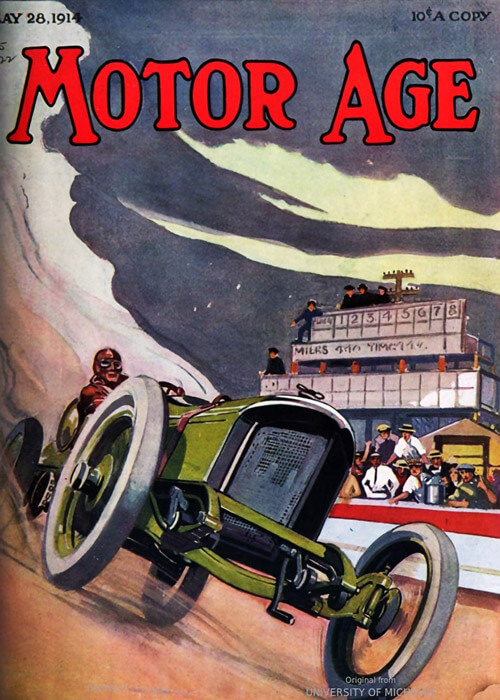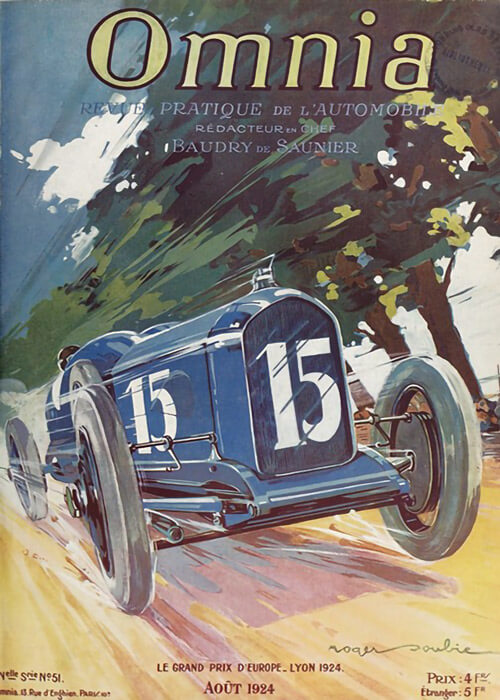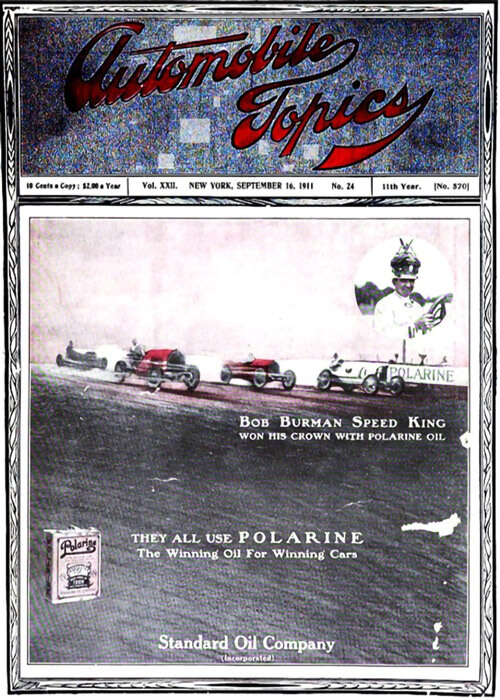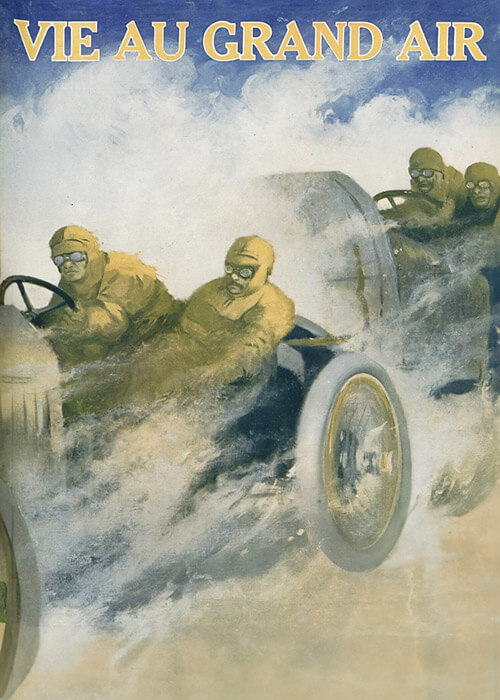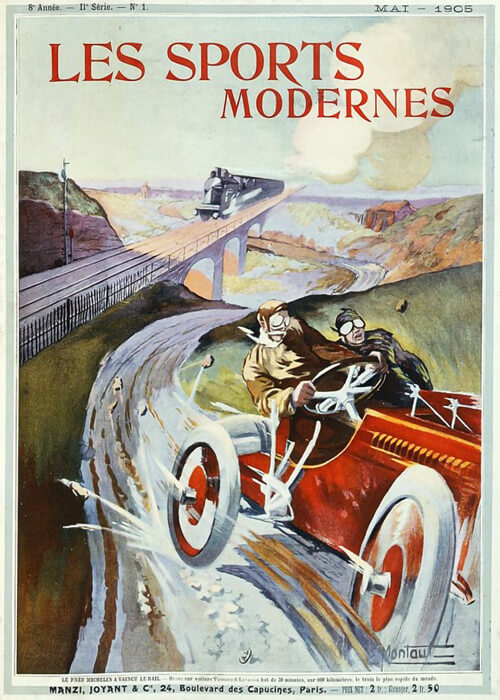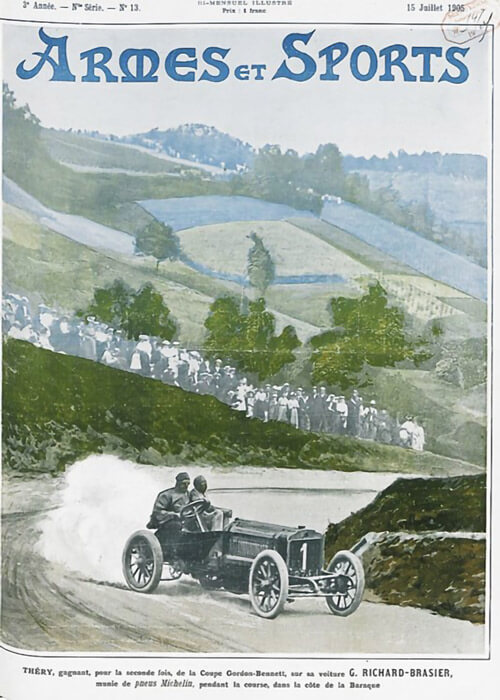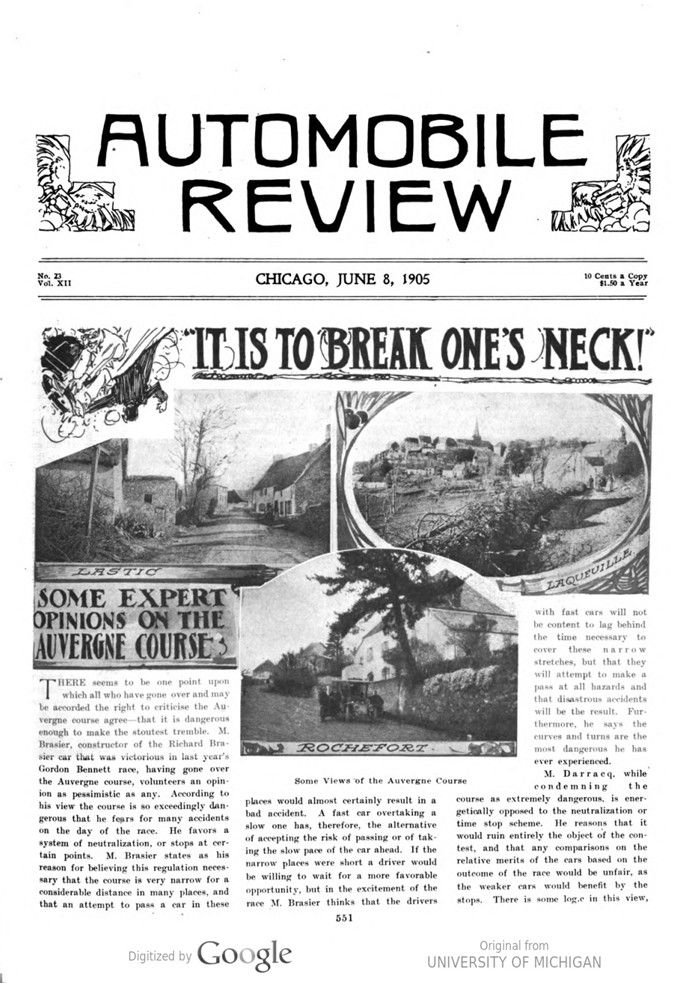
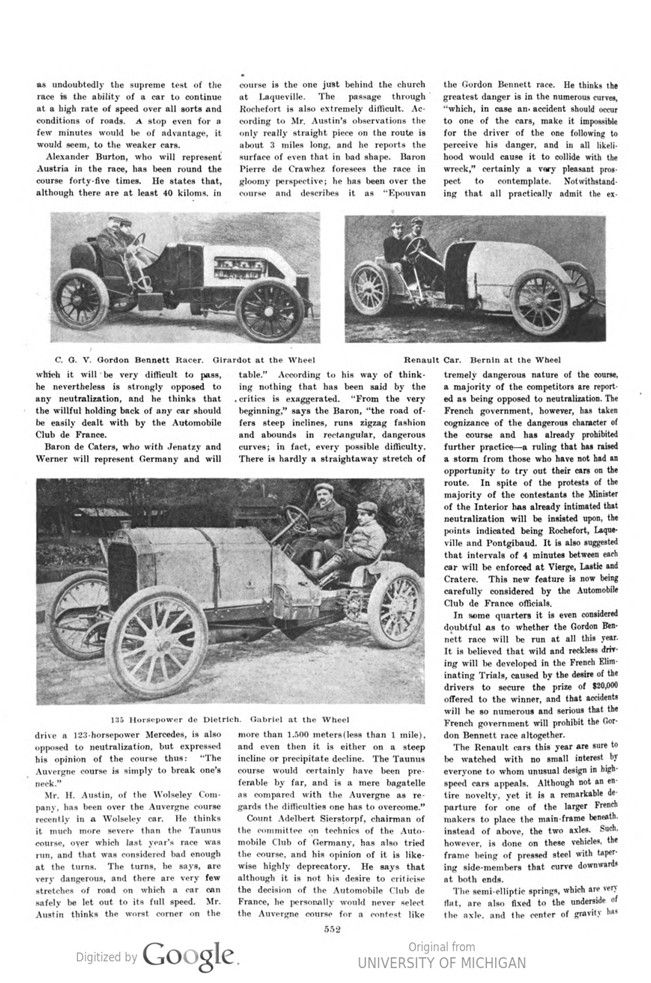
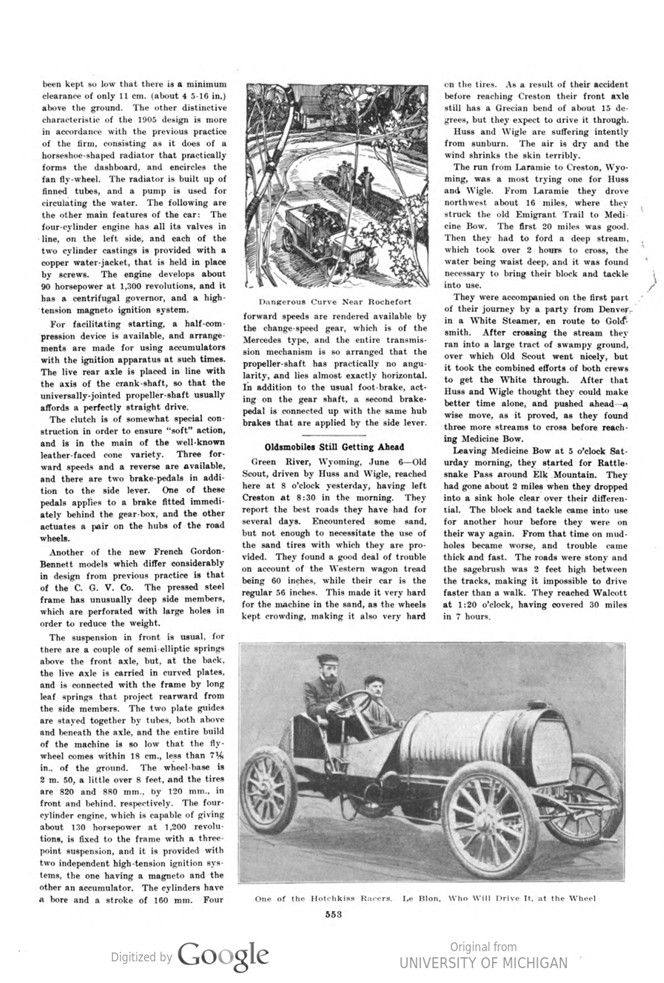
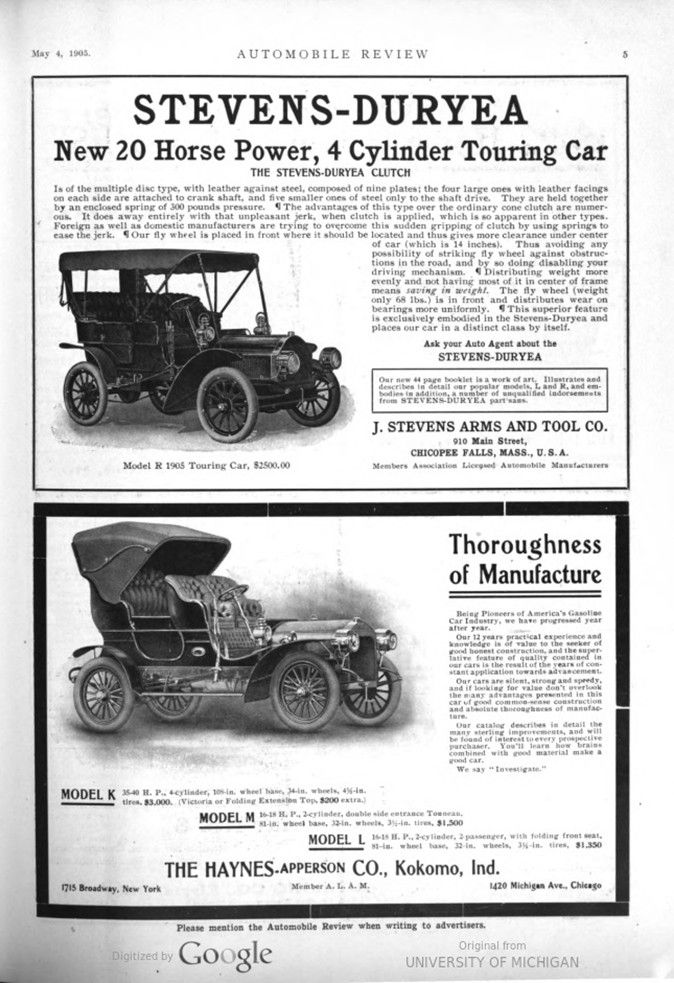
Text and photos with courtesy of hathitrust.org hathitrust.org, compiled by motorracingistory.com
Automobile Review, Vol. 12, No. 23, June 8, 1905
It’s to Break one’s Neck!
some expert Opinions on the Auvergne Course.
THERE seems to be one point upon gone o and may be accorded the right to criticize the Auvergne course agree – that it is dangerous enough to make the stoutest tremble. M. Brasier, constructor of the Richard Brasier car that was victorious in last year’s Gordon Bennett race, having gone over the Auvergne course, volunteers an opinion as pessimistic as any. According to his view the course is so exceedingly dangerous that he fears for many accidents on the day of the race. He favors a system of neutralization or stops at certain points. M. Brasier states as his reason for believing this regulation necessary, that the course is very narrow for a considerable distance in many places, and that an attempt to pass a car in these places would almost certainly result in a bad accident. A fast car overtaking a slow one has, therefore, the alternative of accepting the risk of passing or of taking the slow pace of the car ahead. If the narrow places were short a driver would be willing to wait for a more favorable opportunity, but in the excitement of the race M. Brasier thinks that the drivers with fast cars will not be content to lag behind the time necessary to cover these narrow stretches, but that they will attempt to make a pass at all hazards and that disastrous accidents will be the result. Furthermore, he says the curves and turns are the most dangerous he has ever experienced.
M. Darracq, while condemning the course as extremely dangerous, is energetically opposed to the neutralization or time stop scheme. He reasons that it would ruin entirely the object of the contest, and that any comparisons on the relative merits of the cars based on the outcome of the race would be unfair, as the weaker cars would benefit by the stops. There is some logic in this view, as undoubtedly the supreme test of the race is the ability of a car to continue at a high rate of speed over all sorts and conditions of roads. A stop, even for a few minutes would be of advantage, it would seem, to the weaker cars.
Alexander Burton, who will represent Austria in the race, has been round the course forty-five times. He states that, although there are at least 40 kiloms. in which it will be very difficult to pass, he nevertheless is strongly opposed to any neutralization, and he thinks that the willful holding back of any car should be easily dealt with by the Automobile Club de France.
Baron de Caters, who with Jenatzy and Werner will represent Germany and will drive a 123-horsepower Mercedes, is also opposed to neutralization, but expressed his opinion of the course thus: „The Auvergne course is simply to break one’s neck.“
Mr. H. Austin, of the Wolseley Company, has been over the Auvergne course recently in a Wolseley car. He thinks it is much more severe than the Taunus course, over which last year’s race was run, and that was considered bad enough at the turns. The turns, he says, are very dangerous, and there are very few stretches of road on which a car can safely be let out to its full speed. Mr. Austin thinks the worst corner on the course is the one just behind the church at Laqueville. The passage through Rochefort is also extremely difficult. Ac- cording to Mr. Austin’s observations the only really straight piece on the route is about 3 miles long, and he reports the surface of even that in bad shape. Baron Pierre de Crawhez foresees the race in gloomy perspective; he has been over the course and describes it as „Epouvan table.“ According to his way of thinking nothing that has been said by the critics is exaggerated. „From the very beginning,“ says the Baron, „the road offers steep inclines, runs zigzag fashion and abounds in rectangular, dangerous curves, in fact, every possible difficulty. There is hardly a straightaway stretch of more than 1,500 meters (less than 1 mile), and even then, it is either on a steep incline or precipitate decline. The Taunus course would certainly have been preferable by far, and is a mere bagatelle as compared with the Auvergne as regards the difficulties one has to overcome.“
Count Adelbert Sierstorpf, chairman of the committee on technics of the Automobile Club of Germany, has also tried the course, and his opinion of it is likewise highly deprecatory. He says that although it is not his desire to criticize the decision of the Automobile Club de France, he personally would never select the Auvergne course for a contest like the Gordon Bennett race. He thinks the greatest danger is in the numerous curves, „which, in case an accident should occur to one of the cars, make it impossible for the driver of the one following to perceive his danger, and in all likelihood would cause it to collide with the wreck,“ certainly a very pleasant prospect to contemplate. Notwithstanding that all practically admit the extremely dangerous nature of the course, a majority of the competitors are report- ed as being opposed to neutralization. The French government, however, has taken cognizance of the dangerous character of the course and has already prohibited further practice – a ruling that has raised a storm from those who have not had an opportunity to try out their cars on the route. In spite of the protests of the majority of the contestants the Minister of the Interior has already intimated that neutralization will be insisted upon, the points indicated being Rochefort, Laqueville and Pontgibaud. It is also suggested that intervals of 4 minutes between each car will be enforced at Vierge, Lastic and Cratere. This new feature is now being carefully considered by the Automobile Club de France officials.
In some quarters it is even considered doubtful as to whether the Gordon Bennett race will be run at all this year. It is believed that wild and reckless driving will be developed in the French Eliminating Trials, caused by the desire of the drivers to secure the prize of $20,000 offered to the winner, and that accidents will be so numerous and serious that the French government will prohibit the Gordon Bennett race altogether. The Renault cars this year are sure to be watched with no small interest by everyone to whom unusual design in high-speed cars appeals. Although not an entire novelty, yet it is a remarkable departure for one of the larger French makers to place the main frame beneath. instead of above, the two axles. Such, however, is done on these vehicles, the frame being of pressed steel with tapering side-members that curve downwards at both ends.
The semi-elliptic springs, which are very flat, are also fixed to the underside of the axle, and the center of gravity has been kept so low that there is a minimum clearance of only 11 cm. (about 4 5-16 in.) above the ground. The other distinctive characteristic of the 1905 design is more in accordance with the previous practice of the firm, consisting as it does of a horseshoe-shaped radiator that practically forms the dashboard, and encircles the fan fly-wheel. The radiator is built up of finned tubes, and a pump is used for circulating the water. The following are the other main features of the car: The four-cylinder engine has all its valves in line, on the left side, and each of the two-cylinder castings is provided with a copper water-jacket, that is held in place by screws. The engine develops about 90 horsepower at 1,300 revolutions, and it has a centrifugal governor, and a high-tension magneto ignition system.
For facilitating starting, a half-compression device is available, and arrangements are made for using accumulators with the ignition apparatus at such times. The live rear axle is placed in line with the axis of the crankshaft, so that the universally jointed propeller-shaft usually affords a perfectly straight drive.
The clutch is of somewhat special construction in order to ensure „soft“ action and is in the main of the well-known leather-faced cone variety. Three forward speeds and a reverse are available, and there are two brake-pedals in addition to the side lever. One of these pedals applies to a brake fitted immediately behind the gearbox, and the other actuates a pair on the hubs of the road wheels.
Another of the new French Gordon-Bennett models which differ considerably in design from previous practice is that of the C. G. V. Co. The pressed steel frame has unusually deep side members, which are perforated with large holes in order to reduce the weight.
The suspension in front is usual, for there are a couple of semi-elliptic springs above the front axle, but, at the back, the live axle is carried in curved plates and is connected with the frame by long leaf springs that project rearward from the side members. The two plate guides are stayed together by tubes, both above and beneath the axle, and the entire build of the machine is so low that the flywheel comes within 18 cm., less than 7-1/8 in. of the ground. The wheelbase is 2 m. 50, a little over 8 feet, and the tires are 820 and 880 mm., by 120 mm., in front and behind, respectively. The four-cylinder engine, which is capable of giving about 130 horsepower at 1,200 revolutions, is fixed to the frame with a three-point suspension, and it is provided with two independent high-tension ignition systems, the one having a magneto and the other an accumulator. The cylinders have a bore and a stroke of 160 mm. Four forward speeds are rendered available by the change-speed gear, which is of the Mercedes type, and the entire transmission mechanism is so arranged that the propeller-shaft has practically no angularity, and lies almost exactly horizontal. In addition to the usual footbrake, acting on the gear shaft, a second brake-pedal is connected up with the same hub brakes that are applied by the side lever.
Foto captions, 551 – 553
LASTIC – ROCHEFORT – LAQUEUILL
Some Views of the Auvergne Course
C. G. V. Gordon Bennett Racer. Girardot at the Wheel
Renault Car. Bernin at the Wheel
135 Horsepower de Dietrich. Gabriel at the Wheel
Dangerous Curve Near Rochefort
One of the Hotchkiss Racers. Le Blon, Who Will Drive It, at the Wheel
